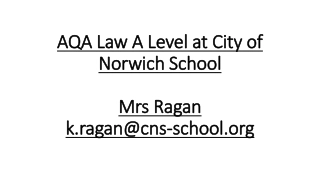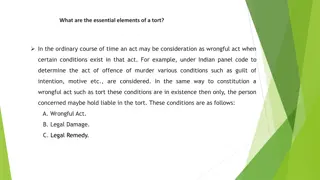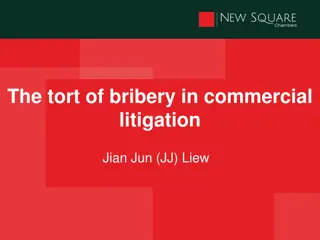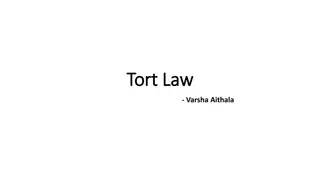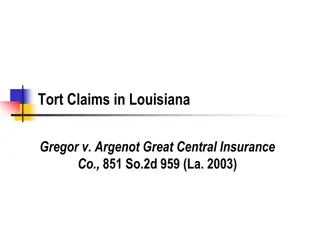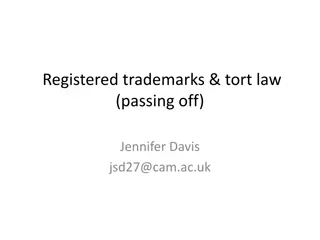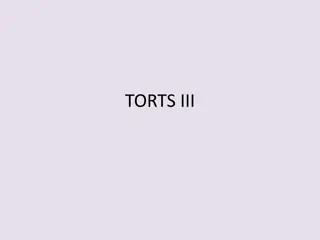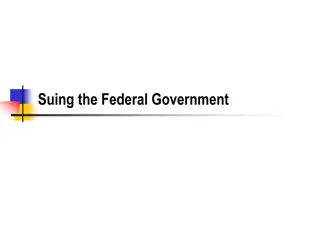
Ethics and Legal Aspects of Artificial Intelligence in Europe
Explore the intersection of artificial intelligence and tort law, understanding the implications of negligence in AI systems. Learn about the main objectives of tort law, the distinction between torts and criminal offenses, and the significance of individual torts in the context of AI systems.
Download Presentation

Please find below an Image/Link to download the presentation.
The content on the website is provided AS IS for your information and personal use only. It may not be sold, licensed, or shared on other websites without obtaining consent from the author. If you encounter any issues during the download, it is possible that the publisher has removed the file from their server.
You are allowed to download the files provided on this website for personal or commercial use, subject to the condition that they are used lawfully. All files are the property of their respective owners.
The content on the website is provided AS IS for your information and personal use only. It may not be sold, licensed, or shared on other websites without obtaining consent from the author.
E N D
Presentation Transcript
Master programmes in Artificial Intelligence 4 Careers in Europe University of Cyprus MAI631 Artificial Intelligence Ethics II Michael Chatzipanagiotis September December 2023
Master programmes in Artificial Intelligence 4 Careers in Europe University of Cyprus Lecture 8: AI & Tort Law Michael Chatzipanagiotis
AI and Tort Law AI and Tort Law Michael Chatzipanagiotis Assistant Professor in Private Law mchatz07@ucy.ac.cy
What is a tort? Breach of a duty that the law imposes on someone (defendant/ wrongdoer), in order to protect legal rights and interests of another person (claimant/ victim). In other words: A wrong committed against someone, resulting in the right of that person to claim compensation (or other remedies) from the wrongdoer. There are many different torts/ wrongs, each one of which is subject to specific rules, e.g. negligence, defamation, assault, deceit etc. They may regard both natural persons and legal entities (e.g. companies, associations, foundations, municipalities etc.) 4
Main objectives of tort law 1. Protection of fundamental rights (e.g. life, property, private life and privacy) + balance of interests protected by fundamental rights (e.g. freedom of speech vs right to private life) 2. Compensation of victims (= to restore victims to the condition that they would have been, if the tort against them had not been committed) 3. Establishment of illegal behaviours 4. Allocation of risks arising from human activities, e.g. liability of the manufacturer of defective products despite the absence of any negligence. 5. Filling legal gaps (e.g. new situations arising from technological development) 5
Distinction between torts and criminal offences Torts Criminal offences Aim at punishing the offender s behavior Sources: Statute Protection of society in general Proof: Beyond any reasonable doubt. The prosecutor bears the burden of proof for the establishment of liability. Aim at restoring/ compensating the victim Sources: Judicial judgments + statutes Protection of private interests Proof: Balance of possibilities (>50%). The claimant bears the burden of proof the establishment of liability. 6
Individuals torts and AI systems Individuals torts and AI systems 7
Negligence Negligence damage of the victim caused by failure of the defendant to demonstrate the reasonable care than an average prudent person would show in place of the defendant under the same factual circumstances. Problem with AI systems: - Defendants and their respective duties (operator, manufacturer, other)? - What is the appropriate standard of care regarding AI systems (given that the AI systems can modify their behavior or e.g. that these systems have different abilities than humans)? - Causation between the behavior of the wrongdoer and the damage of the victim, in view of self-learning abilities of AI systems and black-box effect ? - Allocation of liability among multiple defendants in their inner relationship (i.e. after the victim has been compensated)? 8
Example: Self Example: Self- -driving cars (automated vehicles) driving cars (automated vehicles) https://www.youtube.com/watch?v=7mxG4IBoMes https://www.youtube.com/watch?v=Hb_u6P31xQ4 https://www.scientificamerican.com/article/who-is-liable-when-ai- kills1/ Ethical parameters https://onlineethics.org/cases/questions-tesla-motors-about-autopilot 9
Strict liability under the Product Liability Directive Strict liability under the Product Liability Directive (Directive 85/374/EEC) (Directive 85/374/EEC) Producer liable if product is defective , irrespective of negligence. Producer = end manufacturer, component manufacturer, importer (etc.) Product = a tangible, movable object Defectiveness = non-compliance with reasonable consumer expectations taking into account all circumstances of the particular case. Damage of the defective product itself is not compensated. No liability if the defect arose after the product was put into the market. 10
Defamation Defamation a statement made by one person, which harms the reputation of another person, i.e. of the way other persons think about the latter person. No negligence required. Legal challenges regarding generative AI systems. https://www.youtube.com/watch?v=MaANSBK7rx8 https://www.theverge.com/2023/6/9/23755057/openai-chatgpt- false-information-defamation-lawsuit 11
Digital Services Act (Regulation 2022/2065) Digital Services Act (Regulation 2022/2065) Liability for content moderation Liability for content moderation Arts 4-6: Providers of intermediary services not liable for content produced/ posted etc. by users, unless they are aware of it or should have been aware of it. Arts 33-35 for Very Large Online Platforms: Duty to prevent dissemination of illegal and/or harmful content. 12
Potential solutions Potential solutions Liability for AI operations irrespective of negligence? AI as a tool? AI to be treated as an animal (strict liability of the owner)? AI as an independent actor via attribution of separate legal personality (AI legal entity)? [Mandatory insurance requirements for operators of AI systems] although it helps victims, it merely transfers the problem to the level of liable defendants and their insurers 13
Initiatives at EU level Initiatives at EU level Commission proposal for revision of the Product Liability Directive Product to include software Defectiveness presumed if non-compliance with mandatory safety requirements (which includes EU harmonized standards) Duty of producers to ensure safety of the product throughout its life cycle. Commission proposal on an AI Liability Act Presumptions of defectiveness if the court asks AI operator for disclosure of evidence and operator fails to conform. Presumptions of causal link for high-risk AI systems if they violate provisions of the AI Act. Individual remedies for violations of the AI Act (under negotiation) 14
Thank you! Thank you!
Master programmes in Artificial Intelligence 4 Careers in Europe Questions?

